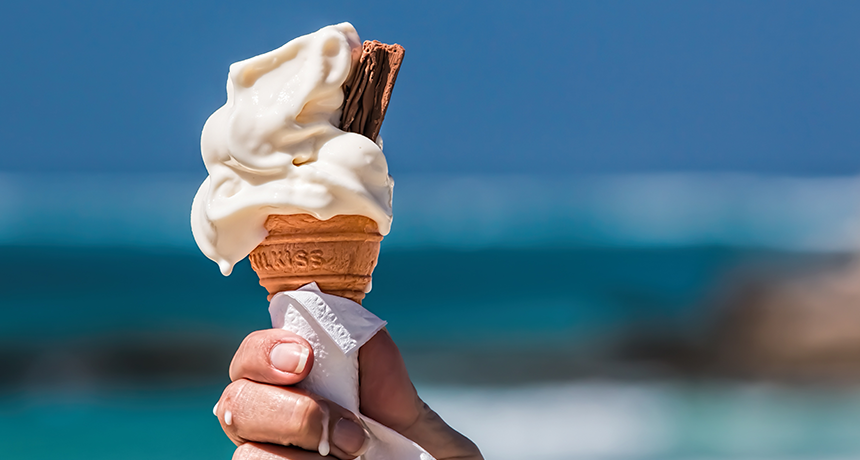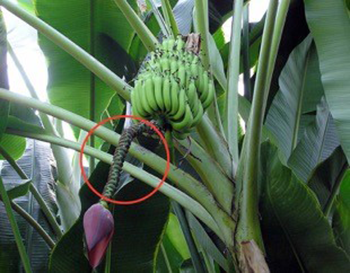Banana plant extract can slow how fast ice cream melts
Tiny plant particles delay the speed at which this treat will turn into a soupy mess

Scientists are looking to change the recipe for ice cream so that this yummy treat won’t melt before we get to eat it.
Bestwork/iStockphoto
Ice cream can be a cool treat on a warm day. But eat it too slowly and you could soon have a sticky mess on your hands. Researchers have searched for ways to slow ice cream’s melting. Now they report some success.
Tiny particles from the ground-up stems of banana plants can help a scoop of ice cream keep its shape longer, they report. The engineers presented their findings March 21 at a meeting of the American Chemical Society in New Orleans, La.
Ice cream is a complex mixture of fat droplets, water, sugar, air bubbles and ice. All of these ingredients can affect how quickly or slowly ice cream melts, explains Jorge Velásquez Cock. He’s a chemical engineer and graduate student at Pontifical Bolivarian University in Medellín, Colombia. There, he uses chemistry to improve the texture and taste of ice cream.
Fat is especially important. The number of fat droplets in ice cream helps determine how quickly it will start to drip. Lower fat recipes will lead to ice cream with fewer fat droplets. These ice creams tend to “collapse” into a drippy mess faster than higher-fat versions. Fat droplets create obstacles for water to move around as the ice crystals melt, Velásquez Cock explains. That “increases the viscosity of the mixture,” he notes. Viscosity is a measure of how easily a liquid flows. Liquids with high viscosity (such as ketchup) flow more slowly than those with a low viscosity (such as water).
But on a warm day, even high-fat ice creams can turn soupy in minutes. Velásquez Cock suspected some new ingredient might extend how long your ice cream remains firm. And to find it, he turned to the garbage can.
Thickening the mix
Velásquez Cock lives near a banana-growing region of Colombia, a nation in South America. Bananas grow in bunches from towering plants that look like trees. A thick stalk attaches each banana bunch to the plant’s trunk. Banana growers consider these woody stalks as garbage.
Finding ways to recycle banana wastes has been part of Velásquez Cock’s research. The stalks are rich in cellulose. It’s a molecule that helps make plant cells stiff. Indeed, wood pulp is a major source of cellulose. That chemical is what makes tree branches and stems so strong.
Cellulose has many uses outside of plants. It’s an ingredient in paper, cellophane and certain types of fabric. It’s also used in some foods. Cellulose molecules stretch out and take up more space as they dissolve in water. This allows them to increase the thickness or viscosity of a liquid. That’s why food scientists sometimes add cellulose to sauces or salad dressings — it can impart a thick, creamy texture.

Velásquez Cock wanted to test whether cellulose from banana stalks might help keep ice cream from turning soupy. He used a special machine to extract tiny bits of cellulose from ground-up banana stalks. The width of each piece was less than a thousandth the width of a human hair.
For the next step, Velásquez Cock worked with his advisor, Robin Zuluaga Gallego, and with Douglas Goff, a food scientist at the University of Guelph in Canada. The trio added the banana plant bits to ice creams with differing amounts of fat. Then they compared how fast the ice creams melted. Those with cellulose held their shape longer than ice creams without the particles. And among those with cellulose, fat content seemed to greatly affect melt rate.
Most ice cream is about 10 percent fat, by weight. (Low-fat ice creams may have just half as much; rich ice creams may contain around 15 percent fat.) “We saw the biggest differences with the normal fat ice cream,” says Velásquez Cock. Adding cellulose particles at 20° Celsius (68° Fahrenheit) increased by 20 minutes the time it took 120 milliliters (about a half cup) of normal-fat ice cream to start melting. The researchers performed the experiments in a closed chamber with no air movement. Just to be clear, that’s not like leaving it on a countertop. Under these artificial conditions, it usually takes that much ice cream a little more than two hours to turn completely liquid, Velásquez Cock notes. In the real world, “Air currents or wind can affect melting behavior in unaccounted ways,” he points out.
Like all ice cream, the new creation did eventually melt into a soupy puddle. But the added cellulose, he says, meant “you can enjoy a little bit longer.”
Building a better ice cream
Richard Hartel is a food scientist who studies ice cream at the University of Wisconsin in Madison. Many ice cream makers already add ingredients to help ice cream keep its shape and to limit it dripping, he notes. These substances are known as hydrocolloids. They form a gel when mixed with water. Some hydrocolloids used in ice cream include a substance from seaweed (carrageenan), and from carob gum, which is derived from the seeds of the carob tree.
Hartel says he’s “interested to see if the cellulose fibers [from the banana plant] have an advantage over standard hydrocolloids.”
The new study suggests adding banana cellulose might improve ice cream. Still, the researchers have no good way to take the idea out of the lab and into the ice-cream parlor. They need some procedure to efficiently pull large amounts of cellulose from banana wastes. For now, the way they remove the fibers in the lab takes too much time. “The next step is working on ways to make the extraction process more efficient,” explains Zuluaga Gallego.







